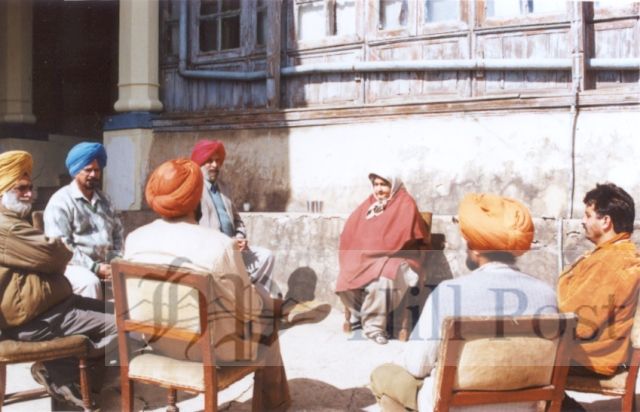Shimla: As more claimants head to court demanding inheritance shareholding in the billions of dollars worth of movable and immovable property of the erstwhile Faridkot Royal house, being a scion could not safeguard Maheepinder Kaur, the youngest daughter of Sir Harinder Singh Brar- the late Maharaja of Faridkot, from spending the last decade of her life in utter penury.

Living in utter isolation, the princess of yore spent the last 12 years of her life living in a small portion of Kennilworth house, one the five majestic cottages that were spread over a sprawling 260 bigha estate at Mashobra near Shimla.
Maheepinder, in one of her last interviews to this correspondent shortly before her death in 2001, confided that she slept on the floor and was apprehensive that all were out to conspire against her.
It was not paranoia but she had reasons to fear. The nearby Sherwood House, another of the five heritage cottages on the sylvan estate, had recently been completely burnt down.

She suspected foul play for the house had no resident and to avoid accidental fire, electric connection had been severed. Besides heritage furniture there were expensive carpets, rare books, paintings and an antique piano in the building that was recorded to have been burnt down.
Cosy Nook, the third cottage empty of all valuables, is more or less like an abandoned property. Honington, the fourth cottage has been used as transit accommodation by visiting members of a trust that was responsible for running the property.
Edelweiss house, named after the Swiss Alpine flower, was completely burned down in 1980, during the lifetime of the late Maharaja of Faridkot who died in 1989
A running property dispute over the royal estates of Faridkot (that was decided court in Chandigarh 0n July 25, 2013) had left the youngest daughter of the once powerful royal house dependent upon the trust, which was simply not enough.
Speaking about her utter state of neglect by the trust she had mentioned, “If it were not for a philanthropist from Ambala supporting me, I would be reduced to utter penury with the Rs 1700 per month being provided by the trust for my living.”

Though the royal garages on the estate, housed vintage cars, which included a Rolls Royce, a Bentley, a Daimler, two Jaguars and two Pacckard’s, Maheepinder moved about in a rundown Maruti van.
Locked up elsewhere on the estate were World War II military carriers of great vintage value. Most of the vintage vehicles were said to be in running condition but lying waste from non-use.
She had then recalled that the military carriers had been used in her father’s election campaign of 1952, which he had won as an independent. The two jaguars were bought for the wedding day of her parents.
Used to much opulence and fond of reading, plight of the princess who died a spinster under mysterious circumstances at Mashobra was that though Kennilworth housed a big library with many rare books bought by her father but she was not even allowed to visit that portion of the cottage.
The court in Chandigarh had ruled that both the sets of wills said to be executed in 1952 and 1982, entrusting the management of the over Rs 20,000 crore property to Maharawal Khewaji Trust, were forged and illegal.
After the courts set aside the contentious will, ownership of the Maharaja’s properties which include over 300 acres of land, an aerodrome at Faridkot, 3 plans, 2 forts, Raj Mahal complex at Faridkot, Faridkot House at prime place in Copernicus Marg, New Delhi, Mani Majra fort in Chandigarh, gold, diamonds lying in lockers, a museum and around two dozen building around the country has passed onto the two surviving daughters Amrit Kaur, who lives in Chandigarh and Deepinder Kaur who lives in Kolkatta.
It was in 1992 that Amrit Kaur, the Chandigarh based eldest daughter of the Maharaja, who had challenged the will in court that had handed the properties to a trust which mainly consisted of former domestic helps of the royal house.
The court ruling came much too late for Maheepinder, who died in 2001 in a private hospital in Shimla, but gauging the large bounty at stake, other members belonging to the royal lineage of Faridkot have since approached the courts, claiming inheritance share in the multi-billion dollar worth of properties.
The trust too is fighting back to keep control over the properties.
File Photos by Ravinder Makhaik
As Editor, Ravinder Makhaik leads the team of media professionals at Hill Post.
In a career spanning over two decades through all formats of journalism in Electronic, Print and Online Media, he brings with him enough experience to steer this platform. He lives in Shimla.




Very good article. What HP youth need more immediately is the training in heritage marketing before the digital marketing. But we do not have an eye for what is heritage, much less the culture, as testi,fied by the burning down of two vintage villas and the state government thinks it would have nothing to do with it. Correct me if I am wrong, but the State government does not even have an archeology or environmental heritage ministry, or department. In countries like UK, there is a ticket even for an ubiquitous “walk along the river”. Something we Indians, too, do take, but often to attend to a Nature’s call. In Spain, as in elsewhere, a house in major tourist destinations is individual property but all put together as a city is collective property of the state. And such burning down of these villas would automatically become state responsibility.
The problem is not that we are not an evolved society, but that we are doing nothing to evolve — as perishing of one heritage symbol other, after British left, stands testimony to this.